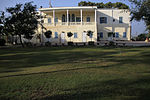Nitzan
1949 establishments in IsraelCommunity settlementsHof Ashkelon Regional CouncilPopulated places established in 1949Populated places in Southern District (Israel) ... and 1 more
Religious Israeli communities

Nitzan (Hebrew: ניצן, lit. Flower bud) is a religiously observant community settlement in southern Israel. Located within the Nitzanim Sand Dune Reserve north of Ashkelon, it falls under the jurisdiction of Hof Ashkelon Regional Council. In 2021 it had a population of 2,660, including a large concentration of Bnei Menashe (10–20% of the population) from India and Myanmar regions bordering India.
Excerpt from the Wikipedia article Nitzan (License: CC BY-SA 3.0, Authors, Images).Nitzan
Neve Dekalim, Hof Ashkelon Regional Council
Geographical coordinates (GPS) Address Nearby Places Show on map
Geographical coordinates (GPS)
| Latitude | Longitude |
|---|---|
| N 31.740277777778 ° | E 34.631111111111 ° |
Address
Neve Dekalim
7751619 Hof Ashkelon Regional Council
South District, Israel
Open on Google Maps










